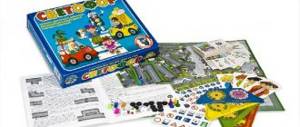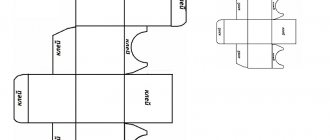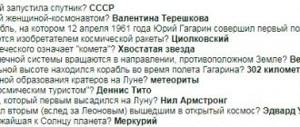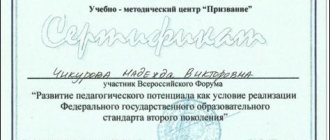Game description
The goal of the participants in the “One Hundred to One” game is to guess the most common answers of people on the street to the proposed questions to which it is impossible to give a definite objective answer, for example, “ What food do the French like most?”
"
The answers are sometimes completely unpredictable and very funny. For example, to the question “ Who maintains order in the country?”
“Ten out of a hundred random passers-by could answer “
windshield wipers
.”
Other example questions: “ What does a woman do when her heel breaks?”
», «
What insects are most often killed?
».
"One Hundred to One" is a team game. Each player must express his opinion, offer his own version, but victory (or defeat) goes to the whole team as a whole. Most often, teams for a TV game are compiled on a professional basis, and popular singers, actors, and athletes often take part in the game.
Rules of the game
The game involves two teams competing, each consisting of five people. The entire gameplay consists of five "games" - simple, double, triple, reverse game and big game.
An important role in the game is played by the scoreboard, which displays the six most popular answers to questions (initially hidden) and three indicators of a miss. In a large game, the scoreboard contains five lines containing two versions named by the players and the number of people who answered the same.
Simple game
A simple game begins with a "draw". Team captains approach a special table with two buttons. Then the presenter announces the question, after which each participant tries to press his button faster than his opponent.
The one who managed to do this names his version of the answer to the question. If a version is on the scoreboard, the corresponding line opens (when the line is opened, the number of points written on it goes into the “game fund”; the number of points is equal to the number of respondents who named this version). If this version turns out to be the most popular among those surveyed and is on the first line of the scoreboard, the presenter continues to play with the team whose player gave the correct answer. Otherwise, the second participant in the drawing tries to answer. If his version turns out to be more popular than the previously named version (located on a higher line of the scoreboard), the turn goes to his team, otherwise the game continues with the opposing team. If none of the two versions is on the scoreboard, the drawing is repeated, but the next team members compete.
Having determined the team, the presenter proceeds to the main part of the game. He interviews players in a circle, who name the answers to the question. If a version is present on the scoreboard, it opens and the points corresponding to the version go into the “pool”; if it is not there, the team gets one miss. The game continues until all six lines of the scoreboard are open (in this case, all points from the “pool” go to the team’s score), or until three misses are scored.
In the latter case, the presenter conducts a so-called blitz survey with the other team. Starting from the end, he learns four versions of the answer to the question from four team members. Then the captain must choose one of the versions of his team members or offer his own. This version is looked for on the scoreboard. If it is there, the points from it are added to the “fund”, which then goes to the team’s score, but if it is not there, the “fund” goes to the opponents.
At the end of the game, the presenter reveals the remaining lines.
Double play and triple play
Double and triple games work exactly the same as the simple game, with the only difference being that the points for each line guessed are doubled or tripled, respectively. Another difference is that the draw is not held between captains, but between the second and third team members, respectively (if a player has already participated in the previous draw, the next participant in order goes).
Game in reverse
| Point distribution | |
| Answer 1 | 15 |
| Answer 2 | 30 |
| Answer 3 | 60 |
| Answer 4 | 120 |
| Answer 5 | 180 |
| Answer 6 | 240 |
The game, on the contrary, differs from others in that it is most profitable for the team to guess not the first line of the scoreboard, but the fifth or sixth.
The question is called, and the teams are given 20 seconds to deliberate, after which the captains name the answers. The command versions must not be the same. The team with the fewest points at the start of the game responds first.
Then the presenter opens the scoreboard. If during the opening process versions of teams are encountered, the points are immediately transferred to their account.
The game, on the contrary, often radically influences the course of the entire program.
Often, questions in the game, on the contrary, begin with the word “ The most ...
", "
The most...
" or "
The most...
", for example, "
The most famous Soviet boxer
."
Big game
The big game involves two players from the team with the most points throughout the program. Before the game starts, they agree among themselves who plays first and who temporarily goes backstage.
After this, the first participant in the big game is given 15 seconds, during which he must answer five questions. For each match between the player’s answer and the answer on the street, a number of points equal to the number of votes for the matching answer are transferred to the “fund” of the big game.
Next, the second player returns from behind the scenes. He does not know the questions and answers of his colleague, as well as the points received for them (however, the state of the “fund” is not hidden). In 20 seconds, he answers the same questions, and if his answer coincides with the first, the player must name a different version. The points for his answers are then tallied and added to the “pool” in the same way.
Once the "pool" reaches 200 points or more during a big game, the game stops and the team is declared the winner of the game.
Interesting Facts
- In 1998, in the anniversary episode dedicated to the third anniversary of the TV game, the players named the word “Kiss” in one of the rounds, but the scoreboard gave a miss and after the end of the round, after checking the unopened answers, the word “Kisse” was opened in one cell. The presenter considered these two words to be the same and gave the whole team a wristwatch because the scoreboard malfunctioned.
- In 2002, an experiment with the “Reverse Game” took place. Based on the known answer options on the scoreboard, the players were asked to guess which question the options answered. We started opening the scoreboard with a rare answer, and then moved on to the most popular one. The team that asked the question received a Leadsinger karaoke microphone.
- In games shown from March to October 2003, a mini-game was played before the Big Game with the captain of the winning team. The presenter asks the captain a question, one way or another related to his profession or hobby. The captain has a minute to write down as many of his own answers as possible on the board with a black marker (maximum 5 answers). After time runs out, four team members try to guess the answers written down by the captain. For each correctly guessed answer, the team will receive 10 bonus points. The maximum you can earn is 40 points, the minimum is 10 points. If points were earned, they were added to the first player's answer to the first question in the Big Game.
- At least three times, if during the course of the game a conflict arose regarding the answer to a question, the then editor-in-chief of the program, Sergei Gorodensky, came into the frame. This happened in the September 7 and December 14, 2008 and October 18, 2009 issues. Earlier, in the issue dated October 7, 2000, the program producer Sergei Pekhletsky came to the studio to solve a similar problem.
- Sometimes there are moments when the leader in the “reverse game” increases the number of points given for the sixth line to 360
(even more rarely - to
480
), thereby giving a chance to a much lagging team to snatch victory from their opponents.
In the episode dated May 26, 2013, the presenter offered 247
points for sixth place. - A unique incident occurred in the issue of September 4, 2010 in the “big game”: the second participant Vardan Markos was “stupefied” by the question “What does a real musician value?”, which is why he did not have time to answer any of the five questions. A similar incident occurred in the issue dated June 8, 2014, where the second participant, Dmitry Chetvergov, lost his allotted time on the question “What English games have spread throughout the world?”
- Together with “Big Bon”, in the “Big Game” issue dated December 9, 2006, a Hummer car was raffled off. The rules of the "Big Game" were changed to the usual six lines, and each member of the team that won the main game fought for himself. A similar “Big Game” with unusual rules was held jointly with the Perekrestok retail chain in the issue dated November 23, 2008.
- In the episode dated January 27, 2013, a unique event occurred in the entire history of the program: both teams (“Kommunalka on Patriarch’s” and “Kommunalka on Baumanka”) scored the same number of points ( 298
). Since the rules did not specify how to act in such a situation, the dispute was resolved through the children's game of “rock, paper, scissors.” Of course, the captains competed. - The June 25, 2020 edition featured six teams rather than two competing. On the left side, graduates of 11 “A” classes from different cities fought, on the right side - 11 “B” classes. In each of the first three games, graduates from two cities took part alternately: on the left side - from St. Petersburg, from Kazan, from Reutov; on the right - from Domodedovo, Ryazan, Rostov-on-Don. In the Reverse Game, each team had 15 participants conferring for 30 seconds. Due to the presence of 15 participants in each team, the prize fund of the game was increased to 150,000 rubles
. Previously, a game with similar tactics was carried out in the issue of June 6, 2004, dedicated to Children's Day. - In the November 5, 2020 edition, due to the fact that the Great Game was played by residents of England, the time for each participant to play the game was doubled, that is, the first player answered questions for 30 seconds, and the second player answered 40 seconds. The same thing was done with the members of the “Overseas Guests” team in the issue dated November 25, 2020, and with the member of the “Marusya” team in the issue of June 14, 2020 (he spoke first and had 20 seconds to answer).
- For the program's 25th anniversary, throughout 2020, following the Triple Game, the host periodically asks players questions used in the program in the late 1990s. This tactic was used with the following questions:
"Who built the pyramid?" (April 19, 2020) “What will a man do after receiving a lot of money?” (April 25, 2020) “You are sitting in front of the TV and are very nervous. What are you watching?" (May 23, 2020) “Why do you need a computer in the house?” (May 24, 2020) “What is the name of the event where many respectable men gather?” (June 27, 2020) “What was stormed?” (July 4, 2020) “What do foreigners think our country has a lot of?” (July 5, 2020) “What abbreviation consists of three letters?” (September 19, 2020) “‘Finally she has arrived!’ Who are they talking about like that?” (September 26, 2020)
Powerpoint games for online lessons
How many wonderful games can be played in an offline lesson... But what if classes are held online? How to make online lessons even more interesting?
Few people know that you can make many interesting interactive games using PowerPoint. We have prepared templates for such popular games as Memory Game, Sapper and Jeopardy.
Sapper
Rules of the game:
Students select a card and click on it. If there is a star hidden behind the card, students receive 1 point if they name the verb correctly. If a bomb is hidden behind a card, students lose all accumulated points. If the X2 sign is hidden behind the card, students’ points are doubled; if there is a prohibiting sign, students receive 0 points, but all accumulated points do not expire.
Download the template for the game Sapper
Jeopardy
Rules of the game:
Students are given 30 questions - 6 topics with 5 questions each. The value of a question varies from 100 to 500 points. The higher the value of the question, the more difficult it is. The main goal is to answer questions and score as many points as possible by the end of the game.
Download the template for the game Jeopardy
Memory Game
Rules of the game:
Students choose two cards (say a number or click on the required card). If the cards match, then they remain; if they do not match, you need to click on them again so that the cards turn over. The one who collects the most pairs wins.
Download template for Memory Game
The first slide provides information on how to edit the template. The second slide is an example of the game. The third slide is the template itself.
See below for how to change pictures ↓
Here is a detailed description of how to create such games:
Do you use Powerpoint to create games? What games do you play?
Maria Cedric
Source: https://skyteach.ru/2019/04/16/igry-v-powerpoint-dlya-onlajn-urokov/
Description of the event “100 to 1”
The goal of the participants: to guess the most common answers of random people from the Internet to the proposed non-standard questions that do not have a clear objective solution.
The game “One Hundred to One” uses exclusive equipment - a specially designed interactive scoreboard, which is reproduced on the screen. It displays tasks in the form of slides containing:
- question
- answers (6 pieces), initially hidden from participants by blanks
- "Cross" buttons, symbolizing misses of both teams
The slides are beautifully animated according to the latest trends in event design. The presenter works in tandem with an assistant, who sits behind a laptop, opens the necessary cells as the game progresses, and maintains the tournament table. Unlike the TV program, the duration of one game of our event is 1 hour thanks to extended rounds.
Order team building
How to make your own game in PowerPoint. Part 1
Play is a natural activity for a child, because children play most of the time. It fully meets their interests and needs. Therefore, the knowledge gained in the game is perfectly absorbed; game tasks are many times superior to repeated exercises in their educational effect.
1. When planning to make an educational presentation game, you must initially determine the learning objectives. Each age has its own program. We determine this for ourselves. For example: the ability to count, know the composition of numbers, classify objects according to certain criteria.
Any game develops. You can note the development of what mental properties and moral qualities your game will contribute to.
Let's find out how
the child must act in the game in order for the learning task to be solved.
The child himself does not need to know your didactic intentions. He is interested in something completely different: (The plot of the game, the motive, the game task and the method of performing the game task).
play motivation for the child
: what will we do, for whom or for what?
For example, we free the stolen numbers from the evil digital saur; we help the Kid complete tasks so that he can then fly to Carlson’s roof; earn stars; we correct someone’s mistakes, etc.
3. We show how to complete the task
: how to do it?
These rules are announced at the beginning of the game, and a sample of how to complete the task is given. It is advisable to show all actions with arrows, flashing icons, highlighting, and increasing the size of the object. This will allow the child to focus on the desired object and remember the order of actions.
For a child who has mastered the rules well and wants to repeat the game, he should be given the opportunity to go to the slide - start the game, without listening to the rules.
Let's make a button to go to the game. To do this, open the “Slide Show” tab - control buttons - custom button:
A button has appeared. We make the desired size, color, write the word “start”. Let's configure the button to move to the 5th slide. Right-click on it and select “action settings”. Set “Follow hyperlink” and select slide number 5 from me.
If desired, you can select the sound. The child likes it when the buttons are voiced.
So, the novice player gets acquainted with the rules on slides 1-4, and the “experienced” player starts right away.
In addition to educational (didactic) games, children prefer to play story games.
When making such a game in PowerPoint, we come up with a plot, characters, and as the action progresses
The child is offered tasks and given a way to complete them. In such games, it is important to provide surprise, unexpected plot twists.
For example, a child plays “Shop” or searches for a song together with cartoon characters and finds clues. It is the entertaining nature of the game, the child’s ability to transform into one or another character, that will allow him to complete any complex task and repeat it many times.
4. Games often ask you to select and show the desired object, word, number or figure.
We are making an autodidactic game: the game itself teaches the child.
This means that if an answer is chosen incorrectly, the slides do not change, and the child hears an “incorrect” sound signal. Only one answer is correct.
Let's place circle buttons with answers.
- In this fragment of the game, the correct answer is the number 6, the rest are incorrect.
- Let's configure the correct answer button to change the slide.
- Right-click on it and in the settings select “follow hyperlink” - “next slide”.
Let the child hear a pleasant sound - encouragement. Check the “sound” box and select it from the menu or “other” - from your own collection of sounds. (WAV format!)
Let’s check the “highlight” box: when the child presses this button, it will change color.
Now let's configure the buttons for incorrect answers. For each, right-click and select “no” in the action settings; similarly, select an “unpleasant” sound from the menu or “other” from your own collection of sounds.
Thus, when the player presses the buttons with the numbers 4, 5, 7, he hears a sound indicating an incorrect answer, the slides will not change.
In games, children are very interested in hearing unusual sounds and phrases from cartoons. Using the Internet, you can select any sounds or make cuts yourself. For example, with the game “Kid and Carlson” I used the “catch phrases” of the characters. By clicking on certain objects in the game, the child hears these phrases, creating the illusion of playing with the characters of his favorite cartoon.
5. Automatic – undesirable slide change for the game.
So far we have it that if a child clicks anywhere in the presentation, the slides will change. And we don’t need this at all. Let's fix the problem. To do this, in the top menu, select the “Slide Show” tab and find “Change Slides”.
Be sure to uncheck the boxes on the right panel “Change slides”: “on click” and “automatically after”.
Now the child will press anywhere to no avail until he finds the correct answer. (Unless, of course, you show him that you can turn the mouse wheel. But you don’t do this, for his own good!)
6. Result.
It is very useful for a preschooler to see the correct answer in the right field and be happy. And a word can please him - encouragement, a cartoon, a new badge earned. This will be an incentive to continue the game and will disguise the didactic task.
Interactive game “One Hundred to One”
(Slide 1)
The game involves two teams of five people each. The team has its own name and its own motto. Teams are given homework: introduce each team member in some original way. At the beginning of the game, the leader appears. He greets all spectators and invites teams to the stage. The teams introduce themselves to each other, after which the game itself begins. The game takes place in 5 rounds and is no different from the television version, except that before the “Game in Reverse” there is a game with spectators. To play the game, you need to prepare cards with answers and think about how to attach them to the board.
PROGRESS OF THE GAME
Round 1. “Simple single game” (Slide 2)
Each point earned by a team is multiplied by one.
Question: What do they hide from children?
1. Matches 58 2. Medicines 12 3. Candies 6 4. Sharp objects 6 5. All 3 6. Books 2
(Slide 3)
Round 2. “Double game” (Slide 4)
Each point earned by a team is multiplied by two.
Question: Where do people meet?
1. Away 27 2. On the street 21 3. In transport 14 4. At work 13 5. At a disco 8 6. In a restaurant 6
(Slide 5)
Round 3. “Triple game” (Slide 6)
Each point earned by a team is multiplied by three.
Question: What can’t you do in class, but you really want to?
1. Chat 41 2. Play 11 3. Sleep 10 4. Laugh 9 5. Cheat 5 6. Eat / Chew 5
(Slide 7)
Round 4. “Game in reverse” (Slide 
Teams are also asked to determine the rarest answer to the question, the answer that is on the very bottom line of the scoreboard. After the presenter asks a question, the teams are given 30 seconds to think about it. Next, the teams take turns saying their versions (the team with the fewest points starts). The presenter opens the entire scoreboard, and after that the teams find out their results. The counting commission calculates the total and determines the team (with more points) that will play the “Big Game”. All players, both the losing and winning teams, are awarded memorable prizes. Question: The most important invention of mankind?
1. Wheel 15 2. Bicycle 30 3. Light, electricity 60 4. TV 120 5. Telephone 180 6. Fire 240
(Slide 9)
Round 5. “Big Game” (Slide 10)
The winning team selects two people who will play in the fifth round. To win the big game, they need to score a total of 200 points. One participant (who will answer the questions second) goes out the door. The first participant is asked 5 questions. He gives an answer to each of them, after which it is determined how many points he scored. Next, a second participant is invited, and he is also asked these questions. If his answer matches the first participant's answer, a beep will sound, after which he will have to change his version and say a different answer. Next, the amount of the “Big Game” is calculated, after which the team either receives a super prize or not.
(Slides 11-20)
| Question 1: Why do parents scare their children? 1. Baba Yaga 28 2. Policeman 21 3. Barmaley 10 4. Wolf 8 5. Babai 3 6. Doctor 3 | Question 2: Who lives in the desert? 1. Camel 43 2. Lizard 19 3. Snake 11 4. Ostrich 8 5. People 5 6. Turtle 2 | Question 3: What do people do on the beach? 1. Sunbathing 51 2. Swimming 12 3. Resting 7 4. Lying 5 5. Staring 4 6. Playing cards 3 |
| Question 4: What do you put in the soup? 1. Salt 50 2. Potatoes 25 3. Water 13 4. Meat 7 5. Vegetables 4 6. Seasoning 2 | Question 5: Who asks too many questions? 1. Children 53 2. Teacher 10 3. Wife / Husband 9 4. Investigator 6 5. Journalist 5 6. Doctor 4 |
(Slides 21, 22)
Literature: Torgashov V.N. On-air news (Holidays. Competitions. Fun. Quizzes. Travel. Tips. Games). Pedagogical Society of Russia. M. 2000
Game "Hundred to One". Questions and answers
The rules of the game correspond to the rules of the famous television game “One Hundred to One”. To play the game, teams (2-6) are formed. A preliminary survey of one hundred people is conducted on the proposed questions and formulas. It is possible to survey another number, then the game can be called “60 to 1”, “45 to 1”, etc. (depending on the number of respondents).
The game takes place in four rounds. For each round, the scoreboard contains a question (task) and the six most popular answers given by the children and adults surveyed. The task of the players (they do not see the answers) is to guess them. The more popular the answer, the more points the team gets. The team that gave three inaccurate (missing on the scoreboard) answers passes its turn to the next team. She, in turn, offers possible versions, and the captain draws a conclusion - he names, in his opinion, the most correct one. If he chooses the answer available on the scoreboard, then all the points earned in this round by the previous team go to his team. If there are not 2, but 4 or 6 teams playing, this is repeated with another question (task).
Before the game, teams determine the order of play by lot. In other rounds, teams change order in pairs.
I round
Task: continue the phrase.
1. Road (signs - 45 people, rules - 28, maps - 11, workers - 8, chores - 5, stories - 3).
2. Railway (ticket - 38 people, crossing - 22, train - 15, bridge - 13, post office -9, district - 3).
3. Safe (movement - 35 people, wheel - 29, behavior - 17, action - 15, event - 4).
4. Forced (stop - 27 people, parking - 23, landing - 28, position - 22).
5. Dangerous (turn - 28 people, load - 25, contact - 18, look - 15, trail - 9, fire - 5).
6. Old (street - 26 people, square - 23, woman - 22, song - 18, record - 8, mill - 3).
7. Public (transport - 32 people, structure - 30, fund - 24, character - 8, order - 6).
Round 2: “Which one? Which?"
Assignment: characterize the subject (choose definitions). Points received in the second round are doubled.
1. Crossroads (regulated - 28 people, unregulated - 24, central - 19, cheerful - 15, noisy - 14).
2. Sign (traffic - 27 people, warning - 23, permitting - 21, prohibiting - 17, mathematical - 9, musical - 3).
3. Turn (left - 26 people, right - 25, steep - 22, new - 14, sharp - 13).
4. Bus (suburban - 27 people, city - 25, intercity - 24, new - 16, comfortable - 6, large - 2).
5. Passenger transport (bus - 27 people, tram - 25, trolleybus - 24, metro - 16, minibus - 8).
6. Special transport (“ambulance” - 29 people, fire - 23, emergency - 20, garbage - 17, truck crane - 11).
Round III: “Colorful answers”
In this round it's the other way around - you need to guess the rarest answer. The team deliberates and gives one collective answer. At the end of this round, the points are summed up and the team with the most points wins.
1. Red (flag - 27 people, light - 23, torch - 14, avenue - 15, poppy - 13, sunset - 18).
2. Blue (frost - 25 people, sky - 24, steamer - 22, flower - 20, cornflower - 16, uniform - 13).
3. Green (onion - 26 people, leaf - 24, dollar - 23, carpet - 17, light - 15, patrol - 5).
4. Yellow (ear - 28 people, sand - 25, metal - 23, lemon - 17, dandelion - 5, color - 2).
5. Black (coal - 25 people, cat - 23, beetle - 16, pencil - 14, coffee - 12, piano - 10).
IV round: Big game “Beginning and End”
Task: two people from the winning team play. The presenter asks 5 questions to one player within 15 seconds (in the absence of the second), and then the second player answers the same questions (within 20 seconds). Matched answers are not counted. The points scored are summed up.
1. Auto... (inspector - 31 people, spare parts - 22, plant - 21, base - 18, park - 8, parking lot - 1).
2. Moto... (club - 24 people, sports - 23, helmet - 22, block - 18, roller - 13).
3. Air... (ticket office - 22 people, ticket - 21, transportation - 20, envelope - 17, flight - 13, club - 7).
4. Cycling... (sports - 24 people, racing - 23, track - 17, cross-country - 15, route - 13, track - 8).
5. Electric... (board - 27 people, kettle - 25, stove - 19, samovar - 17, installer - 7, pump - 5).





